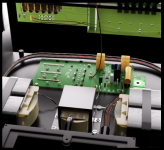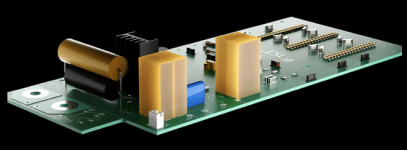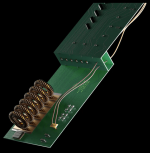Read about the obviously revamped Quad ESL-2812X in TAS:
"...the latest iteration has a re-designed protection circuit that allows it to be played loudly with safety. Let me tell you, walking into a room and hearing Quads, with all their usual splendid virtues, playing at nearly uncomfortably loud levels induces cognitive dissonance. But it happened, so I’m a believer."
Any chance the re-designed protection circuit would be possible to apply on earlier models?
"...the latest iteration has a re-designed protection circuit that allows it to be played loudly with safety. Let me tell you, walking into a room and hearing Quads, with all their usual splendid virtues, playing at nearly uncomfortably loud levels induces cognitive dissonance. But it happened, so I’m a believer."
Any chance the re-designed protection circuit would be possible to apply on earlier models?
Don't you find it weird that if changes were this spectacular there is NOTHING about the "new model" on the website.
Not the official UK website, nor the USA importer MoFi website.
You can't change the law of physics so if no dramatical changes are made to the technical design I have many doubts, but looking forward to hear them and it would be even better to look inside 😳
Not the official UK website, nor the USA importer MoFi website.
You can't change the law of physics so if no dramatical changes are made to the technical design I have many doubts, but looking forward to hear them and it would be even better to look inside 😳
Yeah, but Quad has always been slow to add new products on their website. Amazing that the Revel is up already...
All focus on new box speakers. Like there are non around to choose from (barf)
Much more simple to make, much more profit, much less hassle.
Much more simple to make, much more profit, much less hassle.
I simply disconnected the protection... since i can easy make new panels.
Since i have a power amp with limited power output (but delivers lot of current when needed) and the fact that i limit the frequency response down to 120Hz. They can play approx 10dB higher without any trouble. So no protection sounds best!
Since i have a power amp with limited power output (but delivers lot of current when needed) and the fact that i limit the frequency response down to 120Hz. They can play approx 10dB higher without any trouble. So no protection sounds best!
The physics of the panels has not changed. IF they are modifying the clamp to clamp at a higher voltage (the only way to get more SPL out of them before clamping), then they are risking or actually damaging panels. With the standard clamping voltage I see burn marks in the panels on the speakers I rebuild. I'm very skeptical of that sort of change, and I'm waiting to hear more about it.
Sheldon
Sheldon
I would love to see a pink noise measurement @ 2 meter on axis to prove that.I simply disconnected the protection... since i can easy make new panels.
Since i have a power amp with limited power output (but delivers lot of current when needed) and the fact that i limit the frequency response down to 120Hz. They can play approx 10dB higher without any trouble. So no protection sounds best!
When i had the clamps installed many years ago and active crossover, i never played that loud so that the clamp circuit went in or amplifier clipped.... and as i mentioned the amp is only delivering 40W class A in 8 ohms (nearly 80W in 4 ohms)
I recently visited the ESL page of QUAD's website and notice a couple things that might be related to the claim of increased SPL.The physics of the panels has not changed. IF they are modifying the clamp to clamp at a higher voltage (the only way to get more SPL out of them before clamping), then they are risking or actually damaging panels. With the standard clamping voltage I see burn marks in the panels on the speakers I rebuild. I'm very skeptical of that sort of change, and I'm waiting to hear more about it.
https://quad-hifi.co.uk/collections/electrostatic-speakers
There is mention of a new 3 layer insulating coating applied to the stators...presumably to increased allowable stator voltages before arcing.
Also, you can see there are now 51 zener diodes in the clamp string rather than the previous 32.
Without getting your hands on one, there is no way of knowing if the actual clamping voltage was increased above the previous 32x220 = 7040Vpeak (5kVrms).


The TL inductors also look to be of a new design, but that shouldn't have any bearing on the SPL capability.

All pictures seems to be rendered.
Regarding insulation coating. If you need accuracy in a process and repeatability, an automated spraying station is preferred. = No human errors = quality.
So lots of marketing jadajada.
The delay coils looks like toroid's, and not air wound coils. Baad feeling. And the thickness of the wire? Nope!! Fake
Regarding insulation coating. If you need accuracy in a process and repeatability, an automated spraying station is preferred. = No human errors = quality.
So lots of marketing jadajada.
The delay coils looks like toroid's, and not air wound coils. Baad feeling. And the thickness of the wire? Nope!! Fake
That is 110% marketing babble and I've been seeing it for years from them. Those renderings are not at all accurate. The delay line coils are not toroids, and are way more turns of much finer wire than is depicted. But I've done that on CAD designs before as well just to get the point across. The renderings look like they piggybacked a film cap on the big 220uF input cap. since they remade the PCB (at least in cad land), they really should put that down on the PCB properly.
They are still doing that weird stacked full wave bridge rectifier clamp design. You'd think someone somewhere in the last 45 years would consider changing that. But nothing on that PCB has materially changed.
As for the spray, they have been spraying insulating coatings on the stators for a while. maybe they are doing a thicker coating, but I can promise you that the corners (where it matters) is thin because that's the way liquid coatings work.
Sheldon
They are still doing that weird stacked full wave bridge rectifier clamp design. You'd think someone somewhere in the last 45 years would consider changing that. But nothing on that PCB has materially changed.
As for the spray, they have been spraying insulating coatings on the stators for a while. maybe they are doing a thicker coating, but I can promise you that the corners (where it matters) is thin because that's the way liquid coatings work.
Sheldon
@stokessd,
I thought perhaps the special application method they mentioned was using electrostatic field techniques similar to power coating to get good coverage on corners and sharp edges.
I understand about renderings not necessarily being representative of actual parts, but the layout and component types generally are.
Have you seen any clamp/limiter circuits with surface mount diodes and zeners? If so, did you happen to notice the number of zeners and their part number?
Like you already said, they can't get higher SPL without increasing the limiter threshold.
I thought perhaps the special application method they mentioned was using electrostatic field techniques similar to power coating to get good coverage on corners and sharp edges.
I understand about renderings not necessarily being representative of actual parts, but the layout and component types generally are.
Have you seen any clamp/limiter circuits with surface mount diodes and zeners? If so, did you happen to notice the number of zeners and their part number?
Like you already said, they can't get higher SPL without increasing the limiter threshold.
It's possible that they tried some sort of electrostatic spraying, but that would be pretty advanced from everything I've seen come out regarding these speakers.
I've never seen surface mount parts on the original boards, the light up logo boards use surface mount LEDs, with a through-hole ballast resistor. Here's a picture of my 2912's. They might have done a PCB revision after my pair, but I haven't heard about it. Same 220v through-hole zeners
Sheldon


I've never seen surface mount parts on the original boards, the light up logo boards use surface mount LEDs, with a through-hole ballast resistor. Here's a picture of my 2912's. They might have done a PCB revision after my pair, but I haven't heard about it. Same 220v through-hole zeners
Sheldon
You have not bypassed (shorted), bypassed with polyprop or replaced the 220uF electrolytic?
Interesting that the seems to use bees wax, or is it some syntethic coating?
Another question regarding the transformers. Have they been upgraded since the 63´s?
Thanks
Interesting that the seems to use bees wax, or is it some syntethic coating?
Another question regarding the transformers. Have they been upgraded since the 63´s?
Thanks
I have bypassed the 220uF with a 8.2 uF film cap. Not sure it really matters much but it was cheap and easy. That was a picture of the stock configuration for comparison to the renderings above.
That is indeed bee's wax, same as it has been since the 63's, and even back to the original ESL's. In the clamp circuit part packages haven't changed at all.
The input transformers are slightly changes in that they are wound on a plastic former. MY crude electrical measurements and the speaker frequency response says they perform essentially like all the modern quad transformers. The power transformer has also changes slightly in form factor, but puts out essentially the same voltages as the older ESL63 design. The core size is more or less the same, so I'm assuming the total power capacity of the transformer is the same, not that it really matters given what it does. I'm pretty sure these transformers (2912's) are the same as the 988's. So nothing has changes in decades here. It's possible that they are using better core materials, but there really isn't any need to and the lack of innovation anywhere else makes me doubt that.
Here's a picture of the underside of a 988 (it's my quick instructions on how to remove the base).
Sheldon

That is indeed bee's wax, same as it has been since the 63's, and even back to the original ESL's. In the clamp circuit part packages haven't changed at all.
The input transformers are slightly changes in that they are wound on a plastic former. MY crude electrical measurements and the speaker frequency response says they perform essentially like all the modern quad transformers. The power transformer has also changes slightly in form factor, but puts out essentially the same voltages as the older ESL63 design. The core size is more or less the same, so I'm assuming the total power capacity of the transformer is the same, not that it really matters given what it does. I'm pretty sure these transformers (2912's) are the same as the 988's. So nothing has changes in decades here. It's possible that they are using better core materials, but there really isn't any need to and the lack of innovation anywhere else makes me doubt that.
Here's a picture of the underside of a 988 (it's my quick instructions on how to remove the base).
Sheldon
Back to the topic of this thread: You can get a lot more SPL out of a set of quads by not asking them to play bass. cross them over to a good sub with a steep active crossover and you can make some walls shake.
Sheldon
Sheldon
My main question here would be:
How large was/is the real excursion of the Mylar with these speakers.
What if they were using only half (or less) of the available 5 mm (2,5 front and back) until now in all models?
Anyone has proof of the maximum movement of the diaphragm recorded with a high speed camera or something. Would love to see something like that.
Was there extra room left to move without arcing or other problems occurring and thus allowing for higher SPL?
Subs, no thank you. I don't want walls to shake, I want coherency.
How large was/is the real excursion of the Mylar with these speakers.
What if they were using only half (or less) of the available 5 mm (2,5 front and back) until now in all models?
Anyone has proof of the maximum movement of the diaphragm recorded with a high speed camera or something. Would love to see something like that.
Was there extra room left to move without arcing or other problems occurring and thus allowing for higher SPL?
Subs, no thank you. I don't want walls to shake, I want coherency.
My dipole subs is not intended to be used for shaking the walls. That is a misunderstanding. Quite the opposite actually! There is more effective ways to make the wall shaking. I know how to create devices that acts as shakers. Dipole woofers is not pressurizing the room.
They give you 1 extra octave, they increase life span of the QUADs, and they allow 10dB more dynamics. They lift the speakers to correct height. They lower the distortion of the QUADs since much less current is saturating the transformers, etc etc.
They give you 1 extra octave, they increase life span of the QUADs, and they allow 10dB more dynamics. They lift the speakers to correct height. They lower the distortion of the QUADs since much less current is saturating the transformers, etc etc.
- Home
- Loudspeakers
- Planars & Exotics
- QUAD ESL-2812X, any hope for mods?